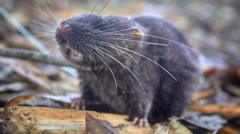An exciting array of 27 new species has been discovered during a recent scientific expedition in the Alto Mayo region of Peru, which is part of the Amazon rainforest. The findings include an amphibious mouse with webbed feet and an unusual blob-headed fish, showcasing the area's extensive biodiversity. The expedition was conducted by scientists from Conservation International together with local indigenous communities.
Trond Larsen, senior director at Conservation International, expressed amazement at the diversity of mammals and vertebrates found in a region heavily impacted by human activity. There may also be up to 48 additional species yet to be confirmed, emphasizing the importance of continued research in the area.
The Alto Mayo region is a protected zone that features multiple ecosystems and indigenous territories, facing challenges from deforestation and agricultural development. Yulisa Tuwi, an Awajún woman involved in the research, highlighted that the report is pivotal in helping the Awajún people safeguard their culture, natural resources, and land. She stressed the community’s extensive traditional knowledge of local wildlife and flora.
Among the newfound species is a dwarf squirrel belonging to a new genus, measuring only 14cm (5.5in), significantly smaller than the average grey squirrel. The team also identified several types of fish, amphibians, and butterflies, including eight new fish species, three new amphibians, and 10 new butterfly varieties.
Additionally, the expedition unveiled a new species of spiny mouse, characterized by stiff guard hairs on their coats reminiscent of hedgehogs. The amphibious mouse stands out among semi-aquatic rodents, which are already considered rare, while a newly discovered climbing salamander is abundant in specific unique habitats.
These exciting discoveries enhance the understanding of biodiversity in the Alto Mayo region and highlight the vital role indigenous communities play in conservation efforts. As unique species continue to be unveiled, the expedition not only contributes to scientific knowledge but also reinforces the Abajún people's connection to their land and associated wildlife.
Trond Larsen, senior director at Conservation International, expressed amazement at the diversity of mammals and vertebrates found in a region heavily impacted by human activity. There may also be up to 48 additional species yet to be confirmed, emphasizing the importance of continued research in the area.
The Alto Mayo region is a protected zone that features multiple ecosystems and indigenous territories, facing challenges from deforestation and agricultural development. Yulisa Tuwi, an Awajún woman involved in the research, highlighted that the report is pivotal in helping the Awajún people safeguard their culture, natural resources, and land. She stressed the community’s extensive traditional knowledge of local wildlife and flora.
Among the newfound species is a dwarf squirrel belonging to a new genus, measuring only 14cm (5.5in), significantly smaller than the average grey squirrel. The team also identified several types of fish, amphibians, and butterflies, including eight new fish species, three new amphibians, and 10 new butterfly varieties.
Additionally, the expedition unveiled a new species of spiny mouse, characterized by stiff guard hairs on their coats reminiscent of hedgehogs. The amphibious mouse stands out among semi-aquatic rodents, which are already considered rare, while a newly discovered climbing salamander is abundant in specific unique habitats.
These exciting discoveries enhance the understanding of biodiversity in the Alto Mayo region and highlight the vital role indigenous communities play in conservation efforts. As unique species continue to be unveiled, the expedition not only contributes to scientific knowledge but also reinforces the Abajún people's connection to their land and associated wildlife.



















